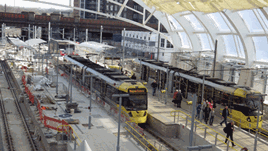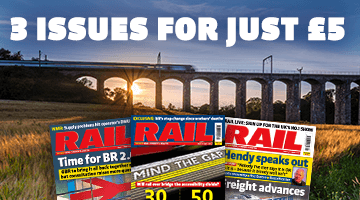So the need to maintain mobility between the ten centres that form Greater Manchester, as well as providing links from further afield, will help shape future rail investment and services. And add to that the demands of tourism - with 1.1 million people visiting the area each year from overseas, Greater Manchester is Britain’s third most popular tourist destination after London and Edinburgh.
Social trends and advancing technology also have an impact, with the Strategy document noting: “Younger people’s travel aspirations are likely to be very different to previous generations, with less emphasis on private car ownership and use. They are more likely to communicate using social networking, rather than relying on face-to-face meetings. When they do travel, they are more likely to consider a range of possible options ‘on the go’, with the support of mobile and wearable devices.”
Meanwhile, at the other end of the age range, older people have an increasing ability and propensity to travel longer distances, through improved health and wealth.
So what sort of new services might be envisaged? It is far too early to say, but possible examples such as a fast Manchester-Milton Keynes-Oxford-Southampton service has long been noted as a possibility once the East West Rail line opens.
And while historically it was a very strong rail corridor, for some time Manchester has had no direct services to Derby, Leicester or the South Midlands, nor to Cambridge and ‘The City’.
Further afield, Manchester has long aspired to direct rail services through the Channel Tunnel, although this is only really possible if the HS2-HS1 link is made in London, and Passport and Customs requirements can be sensibly met.
Nearer to home, there are calls for improved services to the area around Wrexham and the Wirral, on the line through Knutsford to Chester, and for a new service to Carlisle via Settle.
Within Greater Manchester, improved cross-Manchester services to link specific towns might be envisaged, while a proper service between Stockport and Stalybridge is a frequent call of campaigners and local MPs.
“It’s a fact that while the northeast quadrant of the conurbation has more of the people, the job opportunities tend to be in the southwest,” says Lamonte.
“We have around 100,000 students in Manchester, perhaps the largest student body in Europe, and we need to be an attractive place for those people to live and work after graduation.”
Doubtless many more possibilities for new rail services will emerge as studies are undertaken, although all will require new, high-quality rolling stock to attract passengers, as well as the track and platform capacity to match.
Freight is also a vital ingredient of Greater Manchester’s railways, and will grow considerably given the developments at Liverpool Docks and the proposed Port Salford project. The former will bring far more container traffic to Liverpool, and via the Manchester Ship Canal the multi-modal facilities at Port Salford will also add to the capacity required by full-gauge, full-length freight trains passing through Greater Manchester.
TfGM’s scope and remit is focused on addressing the issues within its City Region. But through its involvement with TfN and Rail North, longer-distance rail issues such as access to the airport or the travel needs of tourism can be addressed, says Lamonte.
Linking this with the devolution process, of a range of areas to GM and of rail powers to the North in general, Lamonte turns to the current franchising process:
“What the local authorities right across the North said was that they wanted to take on those franchises. I think when people see the final outcome, they are going to be quite impressed that we have made a real difference in the shape of these franchises, something the Department for Transport would never have done - and I think they’d be the first to recognise that as well.
“Looking beyond this, all the North’s major cities then said: how can we improve the transport links between us in the longer term? And this is where Transport for the North comes in, with its multimodal approach.
“Do we need a higher-speed rail link east to west? Yes we do, and the work that is under way now is looking at what such a line might look like. So TfGM is progressing local issues, is taking a strong role in the new franchises, and is also contributing towards longer-term rail developments across the North.”
Lamonte continues that while devolution plus Rail North “starts to gives us a lot more control over what happens, and far more influence, the big step is Transport for the North, which is not just a partnership with Government, but also with Network Rail, HS2 Limited, Highways England… a powerful group which can really shape the future for the next 20-plus years.”
The £30m allocated to TfN in the July Budget “is a really powerful statement as to the Government’s commitment to the Northern Powerhouse policy”, he adds.
Which takes us full circle, back to the need for Greater Manchester to have a 25-year transport strategy now to tie in with the rest of the long-term thinking and planning.
Turning to the new Northern and TransPennine Express franchises that start in April 2016, Lamonte says: “We have a transformational package against which bidders have been asked to bid. The bids are being evaluated, and there is good thinking there, particularly rolling stock improvements. And if there is one thing the North needs, then it’s new rolling stock.”
He stresses that “it would be absolutely wrong” to think that the two franchise specifications were anything other than robust documents, fully agreed between Rail North and the DfT.
“The influence of local transport authority officers across the North shaped the specification, and there has been a lot of work between the Treasury and the DfT. I have no reason to believe that we won’t see the changes we absolutely need to make rail travel better in the North.”
Rail North will manage the two new franchises alongside the DfT, and Lamonte confirms the ambition for the franchises that will follow in around 2023: “The big next step, the logical step, is that the following franchise or franchises will be set and directed by the North.”
All these changes in the way Greater Manchester’s rail services are managed and developed is leading to a new way of working between TfGM and the rail industry, as TfGM Head of Rail Amanda White explains.
Instead of it being an ‘us and them’ approach, TfGM is now working alongside the train operators so that when, for example, there is a problem with a rail service, TfGM can deploy buses to carry the affected passengers, as well as staff to help give information and guidance on the spot.
And joint Rail North/DfT working groups are looking at the best way to improve the North’s rail services even further, once the new franchises are in place and new trains and new services begin to emerge.
Another group is already examining the effects of pausing the trans-Pennine electrification, and is considering how to react speedily whatever recommendations are made in Sir Peter Hendy’s report, which is due in the autumn.
For example, it might have been assumed that the Class 185 diesel units to be displaced from First TransPennine Express might have moved to the ‘Northern Regional’ services. But if that cascade is delayed, what can operate those services, and what effect does that have on the Government’s oft-repeated promise that all of Northern’s 102 Pacer (Class 142 and 144) units will be withdrawn by the start of 2020?















Login to comment
Comments
No comments have been made yet.